Santa Clara University Leadership Cycle 2: Learning Context Project
VerifiedAdded on 2022/08/13
|21
|5900
|25
Project
AI Summary
This project, undertaken as part of a Leadership Cycle 2 assignment, investigates and analyzes a professional learning context within a school setting. The project begins with an inquiry into collaborative professional learning, examining the role and scope of communities of practice, formal training, and their impact on collaborative learning. It then focuses on selecting an area of educational focus based on student data, establishing a community of practice, and defining the roles of its members. The project further details the planning phase, including identifying a problem of practice related to student behavior, referencing relevant data, and aligning with school priorities. It outlines the chosen approach to professional collaboration, the problem, and the group's strategy to address it. The final steps involve acting on the plan and reflecting on the process, providing video clip annotations and a reflective narrative to assess the impact of the community of practice on student outcomes and teacher development. The project aims to enhance teaching practices and improve student well-being through collaborative efforts and data-driven decision-making.

Running Head: Professional Learning Context
Professional Learning Context
Student Name
Student ID
Professional Learning Context
Student Name
Student ID
Paraphrase This Document
Need a fresh take? Get an instant paraphrase of this document with our AI Paraphraser

2
Professional Learning
Table of Contents
Step 1-Investigate............................................................................................................................3
Step 2-Plan.......................................................................................................................................9
Step 3-Act........................................................................................................................................9
Step 4-Reflect..................................................................................................................................9
References......................................................................................................................................11
Professional Learning
Table of Contents
Step 1-Investigate............................................................................................................................3
Step 2-Plan.......................................................................................................................................9
Step 3-Act........................................................................................................................................9
Step 4-Reflect..................................................................................................................................9
References......................................................................................................................................11
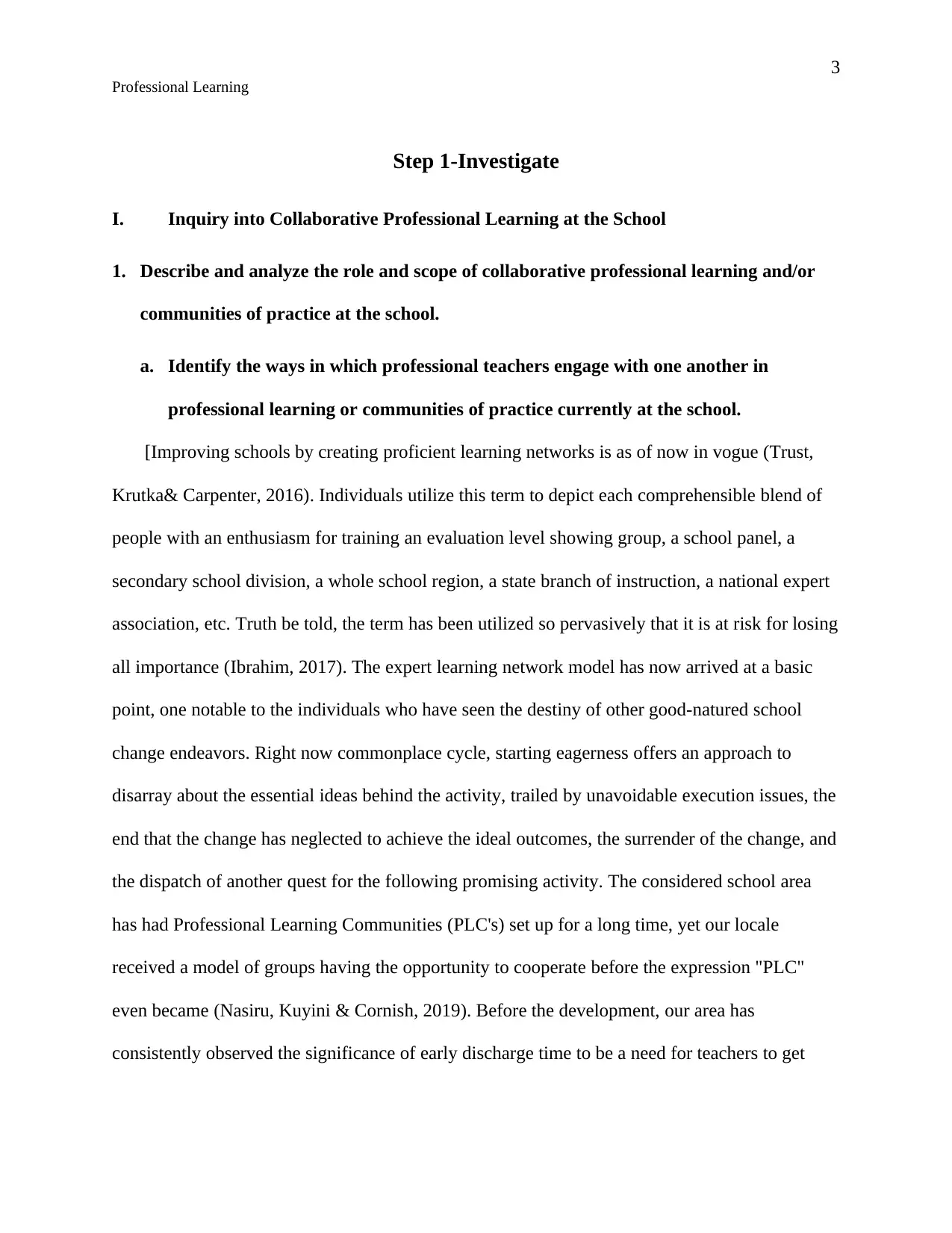
3
Professional Learning
Step 1-Investigate
I. Inquiry into Collaborative Professional Learning at the School
1. Describe and analyze the role and scope of collaborative professional learning and/or
communities of practice at the school.
a. Identify the ways in which professional teachers engage with one another in
professional learning or communities of practice currently at the school.
[Improving schools by creating proficient learning networks is as of now in vogue (Trust,
Krutka& Carpenter, 2016). Individuals utilize this term to depict each comprehensible blend of
people with an enthusiasm for training an evaluation level showing group, a school panel, a
secondary school division, a whole school region, a state branch of instruction, a national expert
association, etc. Truth be told, the term has been utilized so pervasively that it is at risk for losing
all importance (Ibrahim, 2017). The expert learning network model has now arrived at a basic
point, one notable to the individuals who have seen the destiny of other good-natured school
change endeavors. Right now commonplace cycle, starting eagerness offers an approach to
disarray about the essential ideas behind the activity, trailed by unavoidable execution issues, the
end that the change has neglected to achieve the ideal outcomes, the surrender of the change, and
the dispatch of another quest for the following promising activity. The considered school area
has had Professional Learning Communities (PLC's) set up for a long time, yet our locale
received a model of groups having the opportunity to cooperate before the expression "PLC"
even became (Nasiru, Kuyini & Cornish, 2019). Before the development, our area has
consistently observed the significance of early discharge time to be a need for teachers to get
Professional Learning
Step 1-Investigate
I. Inquiry into Collaborative Professional Learning at the School
1. Describe and analyze the role and scope of collaborative professional learning and/or
communities of practice at the school.
a. Identify the ways in which professional teachers engage with one another in
professional learning or communities of practice currently at the school.
[Improving schools by creating proficient learning networks is as of now in vogue (Trust,
Krutka& Carpenter, 2016). Individuals utilize this term to depict each comprehensible blend of
people with an enthusiasm for training an evaluation level showing group, a school panel, a
secondary school division, a whole school region, a state branch of instruction, a national expert
association, etc. Truth be told, the term has been utilized so pervasively that it is at risk for losing
all importance (Ibrahim, 2017). The expert learning network model has now arrived at a basic
point, one notable to the individuals who have seen the destiny of other good-natured school
change endeavors. Right now commonplace cycle, starting eagerness offers an approach to
disarray about the essential ideas behind the activity, trailed by unavoidable execution issues, the
end that the change has neglected to achieve the ideal outcomes, the surrender of the change, and
the dispatch of another quest for the following promising activity. The considered school area
has had Professional Learning Communities (PLC's) set up for a long time, yet our locale
received a model of groups having the opportunity to cooperate before the expression "PLC"
even became (Nasiru, Kuyini & Cornish, 2019). Before the development, our area has
consistently observed the significance of early discharge time to be a need for teachers to get
⊘ This is a preview!⊘
Do you want full access?
Subscribe today to unlock all pages.

Trusted by 1+ million students worldwide
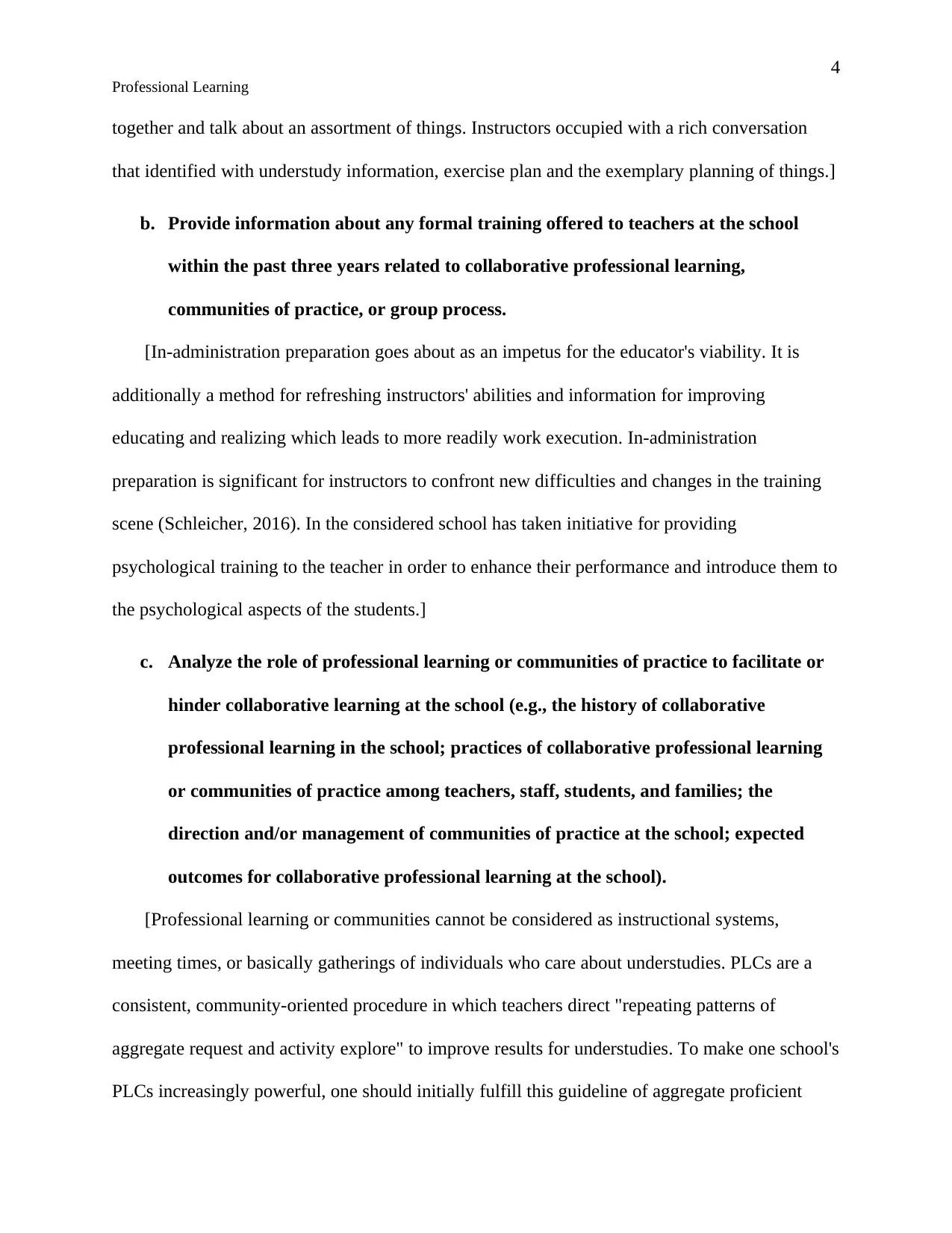
4
Professional Learning
together and talk about an assortment of things. Instructors occupied with a rich conversation
that identified with understudy information, exercise plan and the exemplary planning of things.]
b. Provide information about any formal training offered to teachers at the school
within the past three years related to collaborative professional learning,
communities of practice, or group process.
[In-administration preparation goes about as an impetus for the educator's viability. It is
additionally a method for refreshing instructors' abilities and information for improving
educating and realizing which leads to more readily work execution. In-administration
preparation is significant for instructors to confront new difficulties and changes in the training
scene (Schleicher, 2016). In the considered school has taken initiative for providing
psychological training to the teacher in order to enhance their performance and introduce them to
the psychological aspects of the students.]
c. Analyze the role of professional learning or communities of practice to facilitate or
hinder collaborative learning at the school (e.g., the history of collaborative
professional learning in the school; practices of collaborative professional learning
or communities of practice among teachers, staff, students, and families; the
direction and/or management of communities of practice at the school; expected
outcomes for collaborative professional learning at the school).
[Professional learning or communities cannot be considered as instructional systems,
meeting times, or basically gatherings of individuals who care about understudies. PLCs are a
consistent, community-oriented procedure in which teachers direct "repeating patterns of
aggregate request and activity explore" to improve results for understudies. To make one school's
PLCs increasingly powerful, one should initially fulfill this guideline of aggregate proficient
Professional Learning
together and talk about an assortment of things. Instructors occupied with a rich conversation
that identified with understudy information, exercise plan and the exemplary planning of things.]
b. Provide information about any formal training offered to teachers at the school
within the past three years related to collaborative professional learning,
communities of practice, or group process.
[In-administration preparation goes about as an impetus for the educator's viability. It is
additionally a method for refreshing instructors' abilities and information for improving
educating and realizing which leads to more readily work execution. In-administration
preparation is significant for instructors to confront new difficulties and changes in the training
scene (Schleicher, 2016). In the considered school has taken initiative for providing
psychological training to the teacher in order to enhance their performance and introduce them to
the psychological aspects of the students.]
c. Analyze the role of professional learning or communities of practice to facilitate or
hinder collaborative learning at the school (e.g., the history of collaborative
professional learning in the school; practices of collaborative professional learning
or communities of practice among teachers, staff, students, and families; the
direction and/or management of communities of practice at the school; expected
outcomes for collaborative professional learning at the school).
[Professional learning or communities cannot be considered as instructional systems,
meeting times, or basically gatherings of individuals who care about understudies. PLCs are a
consistent, community-oriented procedure in which teachers direct "repeating patterns of
aggregate request and activity explore" to improve results for understudies. To make one school's
PLCs increasingly powerful, one should initially fulfill this guideline of aggregate proficient
Paraphrase This Document
Need a fresh take? Get an instant paraphrase of this document with our AI Paraphraser
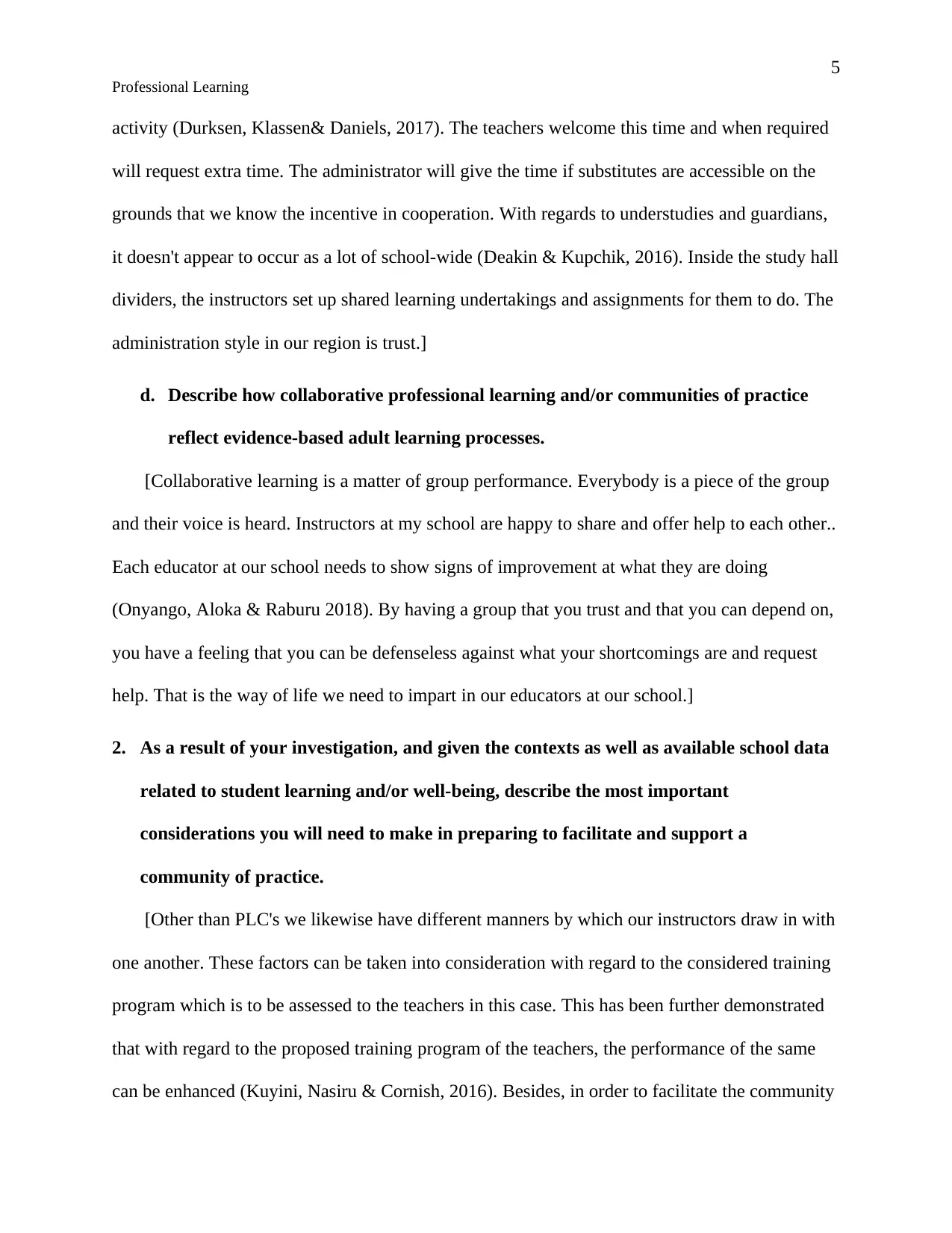
5
Professional Learning
activity (Durksen, Klassen& Daniels, 2017). The teachers welcome this time and when required
will request extra time. The administrator will give the time if substitutes are accessible on the
grounds that we know the incentive in cooperation. With regards to understudies and guardians,
it doesn't appear to occur as a lot of school-wide (Deakin & Kupchik, 2016). Inside the study hall
dividers, the instructors set up shared learning undertakings and assignments for them to do. The
administration style in our region is trust.]
d. Describe how collaborative professional learning and/or communities of practice
reflect evidence-based adult learning processes.
[Collaborative learning is a matter of group performance. Everybody is a piece of the group
and their voice is heard. Instructors at my school are happy to share and offer help to each other..
Each educator at our school needs to show signs of improvement at what they are doing
(Onyango, Aloka & Raburu 2018). By having a group that you trust and that you can depend on,
you have a feeling that you can be defenseless against what your shortcomings are and request
help. That is the way of life we need to impart in our educators at our school.]
2. As a result of your investigation, and given the contexts as well as available school data
related to student learning and/or well-being, describe the most important
considerations you will need to make in preparing to facilitate and support a
community of practice.
[Other than PLC's we likewise have different manners by which our instructors draw in with
one another. These factors can be taken into consideration with regard to the considered training
program which is to be assessed to the teachers in this case. This has been further demonstrated
that with regard to the proposed training program of the teachers, the performance of the same
can be enhanced (Kuyini, Nasiru & Cornish, 2016). Besides, in order to facilitate the community
Professional Learning
activity (Durksen, Klassen& Daniels, 2017). The teachers welcome this time and when required
will request extra time. The administrator will give the time if substitutes are accessible on the
grounds that we know the incentive in cooperation. With regards to understudies and guardians,
it doesn't appear to occur as a lot of school-wide (Deakin & Kupchik, 2016). Inside the study hall
dividers, the instructors set up shared learning undertakings and assignments for them to do. The
administration style in our region is trust.]
d. Describe how collaborative professional learning and/or communities of practice
reflect evidence-based adult learning processes.
[Collaborative learning is a matter of group performance. Everybody is a piece of the group
and their voice is heard. Instructors at my school are happy to share and offer help to each other..
Each educator at our school needs to show signs of improvement at what they are doing
(Onyango, Aloka & Raburu 2018). By having a group that you trust and that you can depend on,
you have a feeling that you can be defenseless against what your shortcomings are and request
help. That is the way of life we need to impart in our educators at our school.]
2. As a result of your investigation, and given the contexts as well as available school data
related to student learning and/or well-being, describe the most important
considerations you will need to make in preparing to facilitate and support a
community of practice.
[Other than PLC's we likewise have different manners by which our instructors draw in with
one another. These factors can be taken into consideration with regard to the considered training
program which is to be assessed to the teachers in this case. This has been further demonstrated
that with regard to the proposed training program of the teachers, the performance of the same
can be enhanced (Kuyini, Nasiru & Cornish, 2016). Besides, in order to facilitate the community

6
Professional Learning
service program, a specific group of people is to be selected for the same. Eventually, the
identified training program will be developed based on the interest of this particular group.]
II. Selecting an Area of Educational Focus Based on Data and Establishing a
Community of Practice
1. Describe the area of educational focus, based on student learning and/or well-being
related data, selected for group professional learning.
[Based on the data so collected, certain issues could be identified that were helpful for
identifying the areas of focus in this case. To be specific, the students are in great need of
professional learning outcomes for their educational growth (Sullivan, 2016). In that case, the
teachers are required to put the focus on the same. In that regard, it can be said that the school
authority can introduce new initiatives for training programs of the teachers in order to
implement the new educational programs.]
2. Provide a list of the members of the group (by role, not name) and the reason(s) for
each member’s inclusion.
School Counselor
[Since this gathering is centered on how to give "increasingly serious mediation" to
understudies with conduct concerns, our advocate presents significant knowledge to what
may be occurring at home, benefits the educators don't realize is accessible and different
assets to help the understudy.]
Teacher delegate from the school
[This individual wants to support understudies and takes a gander at the conduct and what
the understudies' needs are (Kamasheva et al, 2016). They give the point of view from the
Professional Learning
service program, a specific group of people is to be selected for the same. Eventually, the
identified training program will be developed based on the interest of this particular group.]
II. Selecting an Area of Educational Focus Based on Data and Establishing a
Community of Practice
1. Describe the area of educational focus, based on student learning and/or well-being
related data, selected for group professional learning.
[Based on the data so collected, certain issues could be identified that were helpful for
identifying the areas of focus in this case. To be specific, the students are in great need of
professional learning outcomes for their educational growth (Sullivan, 2016). In that case, the
teachers are required to put the focus on the same. In that regard, it can be said that the school
authority can introduce new initiatives for training programs of the teachers in order to
implement the new educational programs.]
2. Provide a list of the members of the group (by role, not name) and the reason(s) for
each member’s inclusion.
School Counselor
[Since this gathering is centered on how to give "increasingly serious mediation" to
understudies with conduct concerns, our advocate presents significant knowledge to what
may be occurring at home, benefits the educators don't realize is accessible and different
assets to help the understudy.]
Teacher delegate from the school
[This individual wants to support understudies and takes a gander at the conduct and what
the understudies' needs are (Kamasheva et al, 2016). They give the point of view from the
⊘ This is a preview!⊘
Do you want full access?
Subscribe today to unlock all pages.

Trusted by 1+ million students worldwide
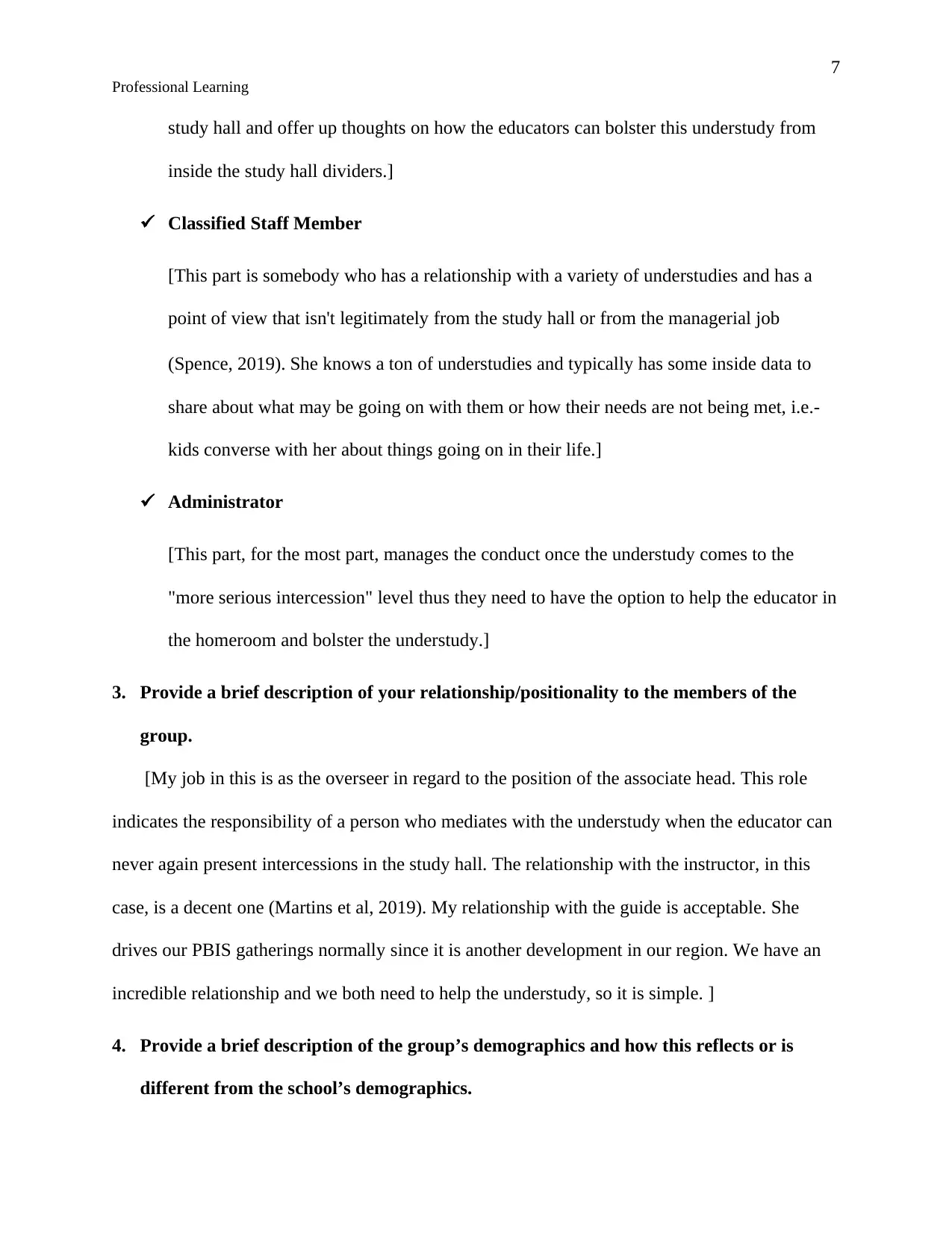
7
Professional Learning
study hall and offer up thoughts on how the educators can bolster this understudy from
inside the study hall dividers.]
Classified Staff Member
[This part is somebody who has a relationship with a variety of understudies and has a
point of view that isn't legitimately from the study hall or from the managerial job
(Spence, 2019). She knows a ton of understudies and typically has some inside data to
share about what may be going on with them or how their needs are not being met, i.e.-
kids converse with her about things going on in their life.]
Administrator
[This part, for the most part, manages the conduct once the understudy comes to the
"more serious intercession" level thus they need to have the option to help the educator in
the homeroom and bolster the understudy.]
3. Provide a brief description of your relationship/positionality to the members of the
group.
[My job in this is as the overseer in regard to the position of the associate head. This role
indicates the responsibility of a person who mediates with the understudy when the educator can
never again present intercessions in the study hall. The relationship with the instructor, in this
case, is a decent one (Martins et al, 2019). My relationship with the guide is acceptable. She
drives our PBIS gatherings normally since it is another development in our region. We have an
incredible relationship and we both need to help the understudy, so it is simple. ]
4. Provide a brief description of the group’s demographics and how this reflects or is
different from the school’s demographics.
Professional Learning
study hall and offer up thoughts on how the educators can bolster this understudy from
inside the study hall dividers.]
Classified Staff Member
[This part is somebody who has a relationship with a variety of understudies and has a
point of view that isn't legitimately from the study hall or from the managerial job
(Spence, 2019). She knows a ton of understudies and typically has some inside data to
share about what may be going on with them or how their needs are not being met, i.e.-
kids converse with her about things going on in their life.]
Administrator
[This part, for the most part, manages the conduct once the understudy comes to the
"more serious intercession" level thus they need to have the option to help the educator in
the homeroom and bolster the understudy.]
3. Provide a brief description of your relationship/positionality to the members of the
group.
[My job in this is as the overseer in regard to the position of the associate head. This role
indicates the responsibility of a person who mediates with the understudy when the educator can
never again present intercessions in the study hall. The relationship with the instructor, in this
case, is a decent one (Martins et al, 2019). My relationship with the guide is acceptable. She
drives our PBIS gatherings normally since it is another development in our region. We have an
incredible relationship and we both need to help the understudy, so it is simple. ]
4. Provide a brief description of the group’s demographics and how this reflects or is
different from the school’s demographics.
Paraphrase This Document
Need a fresh take? Get an instant paraphrase of this document with our AI Paraphraser
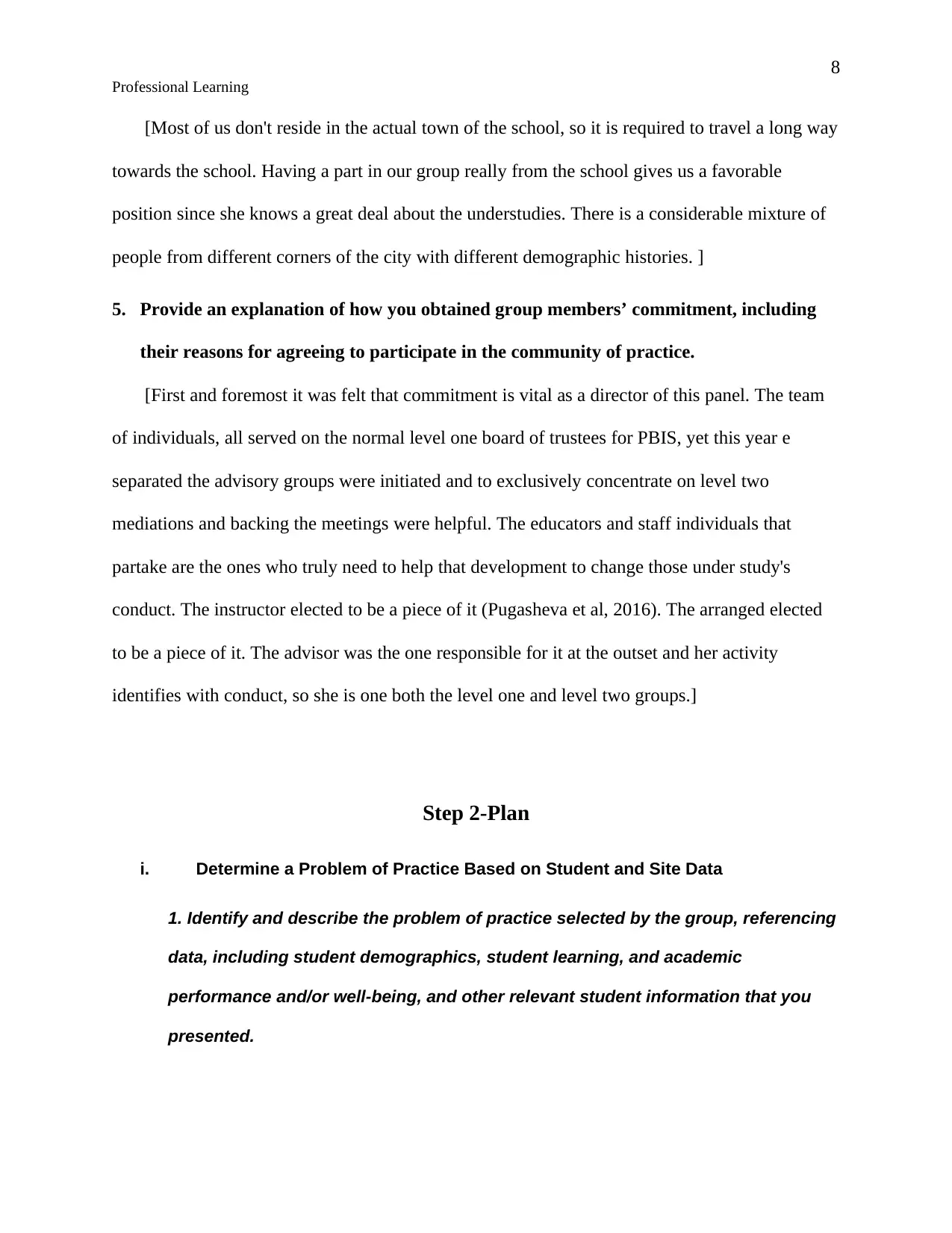
8
Professional Learning
[Most of us don't reside in the actual town of the school, so it is required to travel a long way
towards the school. Having a part in our group really from the school gives us a favorable
position since she knows a great deal about the understudies. There is a considerable mixture of
people from different corners of the city with different demographic histories. ]
5. Provide an explanation of how you obtained group members’ commitment, including
their reasons for agreeing to participate in the community of practice.
[First and foremost it was felt that commitment is vital as a director of this panel. The team
of individuals, all served on the normal level one board of trustees for PBIS, yet this year e
separated the advisory groups were initiated and to exclusively concentrate on level two
mediations and backing the meetings were helpful. The educators and staff individuals that
partake are the ones who truly need to help that development to change those under study's
conduct. The instructor elected to be a piece of it (Pugasheva et al, 2016). The arranged elected
to be a piece of it. The advisor was the one responsible for it at the outset and her activity
identifies with conduct, so she is one both the level one and level two groups.]
Step 2-Plan
i. Determine a Problem of Practice Based on Student and Site Data
1. Identify and describe the problem of practice selected by the group, referencing
data, including student demographics, student learning, and academic
performance and/or well-being, and other relevant student information that you
presented.
Professional Learning
[Most of us don't reside in the actual town of the school, so it is required to travel a long way
towards the school. Having a part in our group really from the school gives us a favorable
position since she knows a great deal about the understudies. There is a considerable mixture of
people from different corners of the city with different demographic histories. ]
5. Provide an explanation of how you obtained group members’ commitment, including
their reasons for agreeing to participate in the community of practice.
[First and foremost it was felt that commitment is vital as a director of this panel. The team
of individuals, all served on the normal level one board of trustees for PBIS, yet this year e
separated the advisory groups were initiated and to exclusively concentrate on level two
mediations and backing the meetings were helpful. The educators and staff individuals that
partake are the ones who truly need to help that development to change those under study's
conduct. The instructor elected to be a piece of it (Pugasheva et al, 2016). The arranged elected
to be a piece of it. The advisor was the one responsible for it at the outset and her activity
identifies with conduct, so she is one both the level one and level two groups.]
Step 2-Plan
i. Determine a Problem of Practice Based on Student and Site Data
1. Identify and describe the problem of practice selected by the group, referencing
data, including student demographics, student learning, and academic
performance and/or well-being, and other relevant student information that you
presented.

9
Professional Learning
[Planning a meeting was crucial as it will help to stimulate the training process at large. The
issues of racial discrimination are to be resolved in the enrolment process of the school. The
school enrolment process increased over time. The school data depicts the rising number of
academic performance (DeGrace et al., 2018). Last year it was found that there was deterioration
of performance among the 9% of the chances students. The enrolment trends in the school
continue to decrease over time among the American Chinese (Pelloso, Basso, Padoan, Fogar &
Plebani, 2016). The population of American Indian found a great decrease in the enrolment.
Latino are found to have taken active participation in the enrolment process in the school. The
school found the financial discrimination among the students. The American Chinese is being
affected by financial discrimination.]
2. How does the problem of practice correspond to school and/or district priorities or
vision; reflect California state standards and/or curriculum frameworks or equivalent,
or other applicable standards; and take into account existing student group
performance differences?
[The existing group performance is found to be satisfactory as American Chinese students are
found to be growing very well over time. The district's focus is to improve the student's
performance as time progresses (Tuman et al., 2017). The students can have a better focus
in the classroom setting to receive a good grade and enhance performance standards. The
focus of the group is to enhance and monitors the performance of the student and their
behavior. The enrolment can be improved with the proper performance development focus. ]
1. Approach for Professional Collaboration and Your Role as Facilitator
Professional Learning
[Planning a meeting was crucial as it will help to stimulate the training process at large. The
issues of racial discrimination are to be resolved in the enrolment process of the school. The
school enrolment process increased over time. The school data depicts the rising number of
academic performance (DeGrace et al., 2018). Last year it was found that there was deterioration
of performance among the 9% of the chances students. The enrolment trends in the school
continue to decrease over time among the American Chinese (Pelloso, Basso, Padoan, Fogar &
Plebani, 2016). The population of American Indian found a great decrease in the enrolment.
Latino are found to have taken active participation in the enrolment process in the school. The
school found the financial discrimination among the students. The American Chinese is being
affected by financial discrimination.]
2. How does the problem of practice correspond to school and/or district priorities or
vision; reflect California state standards and/or curriculum frameworks or equivalent,
or other applicable standards; and take into account existing student group
performance differences?
[The existing group performance is found to be satisfactory as American Chinese students are
found to be growing very well over time. The district's focus is to improve the student's
performance as time progresses (Tuman et al., 2017). The students can have a better focus
in the classroom setting to receive a good grade and enhance performance standards. The
focus of the group is to enhance and monitors the performance of the student and their
behavior. The enrolment can be improved with the proper performance development focus. ]
1. Approach for Professional Collaboration and Your Role as Facilitator
⊘ This is a preview!⊘
Do you want full access?
Subscribe today to unlock all pages.

Trusted by 1+ million students worldwide

10
Professional Learning
2. What is the chosen approach to working with the identified community of practice
and why did the group choose this approach to professional collaboration?
1. [The school has adopted the principle to reduce the discrimination activities and changed
attitude program. The school attempts to reduce the discriminatory trend has developed and
reduced the impact of the trend (Update, 2017). Many measures have been undertaken by the
school to reduce the act of discrimination among the students. The school was found to have
taken steps to provide grants to the immigrant's students and the faculties were asked to
undertake strong measures to improve the students in the field.]
Describe your role as facilitator:
[As our group is small in size, it is our focus to employ the time in the best possible way. All the
group members are aware of removing the barriers to present the act of discrimination in the
school and improve the educational and civilized behavior of the students to improve the
student’s capability.]
b. How do you plan to lead group meetings, develop and support collaborative group
processes, maintain group focus and energy, support individual and group learning,
and monitor the group’s progress?
[ Enhancing the student's capability is the ambition of all the group members. Our focus is to
eradicate the discriminatory act and encourage a learning environment in the school. My role as a
facilitator is to collect the fresh and current data and make a comprehensive analysis of the data
collected (McKellar, Cortina & Ryan, 2020). The individual care has been provided to the group
members allowing them the opportunity to speak without any discrimination. My role is also to
encourage the active participation of the group members. The active participation of the group
member can improve group activities. The conversation will help to reach a proper decision. I
Professional Learning
2. What is the chosen approach to working with the identified community of practice
and why did the group choose this approach to professional collaboration?
1. [The school has adopted the principle to reduce the discrimination activities and changed
attitude program. The school attempts to reduce the discriminatory trend has developed and
reduced the impact of the trend (Update, 2017). Many measures have been undertaken by the
school to reduce the act of discrimination among the students. The school was found to have
taken steps to provide grants to the immigrant's students and the faculties were asked to
undertake strong measures to improve the students in the field.]
Describe your role as facilitator:
[As our group is small in size, it is our focus to employ the time in the best possible way. All the
group members are aware of removing the barriers to present the act of discrimination in the
school and improve the educational and civilized behavior of the students to improve the
student’s capability.]
b. How do you plan to lead group meetings, develop and support collaborative group
processes, maintain group focus and energy, support individual and group learning,
and monitor the group’s progress?
[ Enhancing the student's capability is the ambition of all the group members. Our focus is to
eradicate the discriminatory act and encourage a learning environment in the school. My role as a
facilitator is to collect the fresh and current data and make a comprehensive analysis of the data
collected (McKellar, Cortina & Ryan, 2020). The individual care has been provided to the group
members allowing them the opportunity to speak without any discrimination. My role is also to
encourage the active participation of the group members. The active participation of the group
member can improve group activities. The conversation will help to reach a proper decision. I
Paraphrase This Document
Need a fresh take? Get an instant paraphrase of this document with our AI Paraphraser
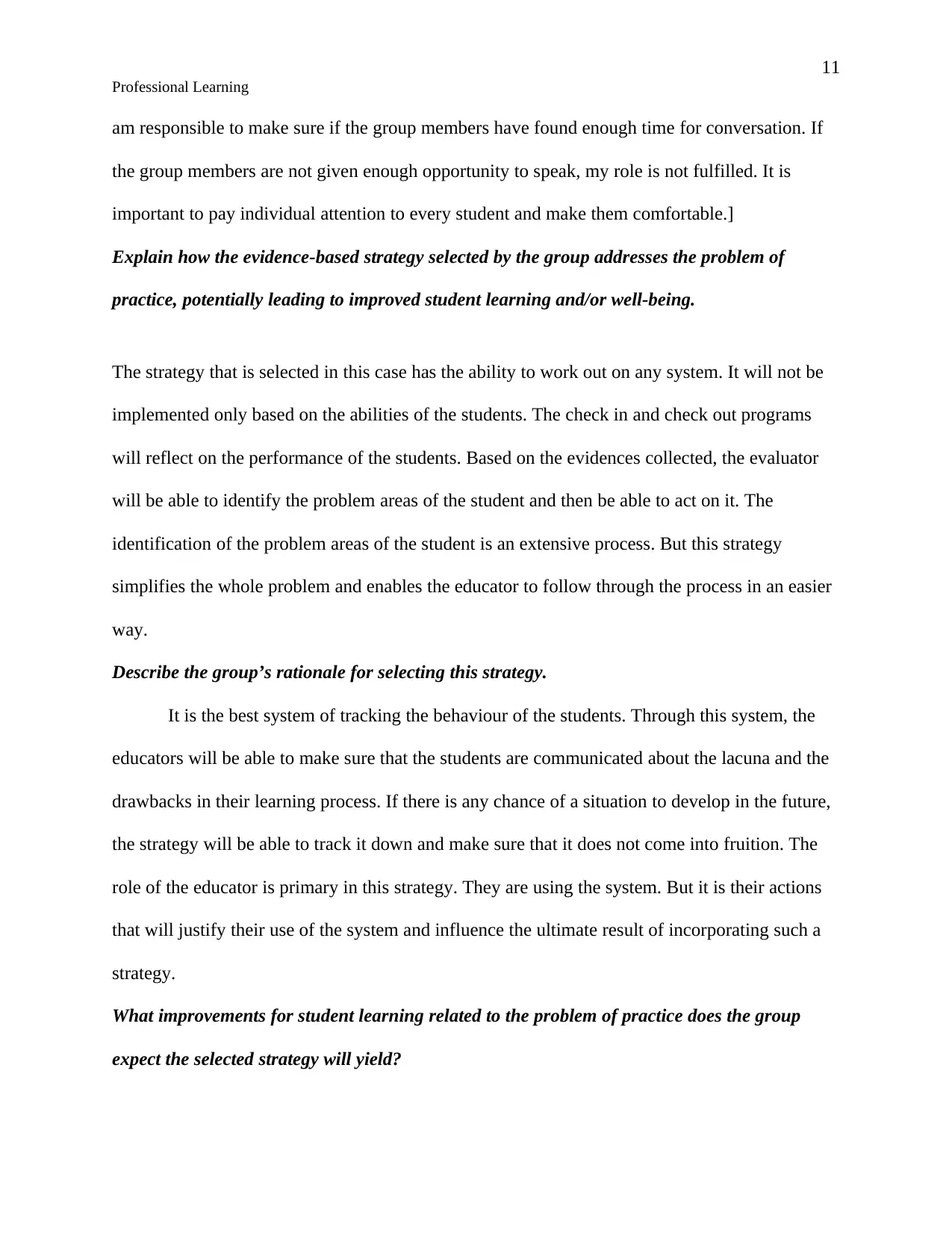
11
Professional Learning
am responsible to make sure if the group members have found enough time for conversation. If
the group members are not given enough opportunity to speak, my role is not fulfilled. It is
important to pay individual attention to every student and make them comfortable.]
Explain how the evidence-based strategy selected by the group addresses the problem of
practice, potentially leading to improved student learning and/or well-being.
The strategy that is selected in this case has the ability to work out on any system. It will not be
implemented only based on the abilities of the students. The check in and check out programs
will reflect on the performance of the students. Based on the evidences collected, the evaluator
will be able to identify the problem areas of the student and then be able to act on it. The
identification of the problem areas of the student is an extensive process. But this strategy
simplifies the whole problem and enables the educator to follow through the process in an easier
way.
Describe the group’s rationale for selecting this strategy.
It is the best system of tracking the behaviour of the students. Through this system, the
educators will be able to make sure that the students are communicated about the lacuna and the
drawbacks in their learning process. If there is any chance of a situation to develop in the future,
the strategy will be able to track it down and make sure that it does not come into fruition. The
role of the educator is primary in this strategy. They are using the system. But it is their actions
that will justify their use of the system and influence the ultimate result of incorporating such a
strategy.
What improvements for student learning related to the problem of practice does the group
expect the selected strategy will yield?
Professional Learning
am responsible to make sure if the group members have found enough time for conversation. If
the group members are not given enough opportunity to speak, my role is not fulfilled. It is
important to pay individual attention to every student and make them comfortable.]
Explain how the evidence-based strategy selected by the group addresses the problem of
practice, potentially leading to improved student learning and/or well-being.
The strategy that is selected in this case has the ability to work out on any system. It will not be
implemented only based on the abilities of the students. The check in and check out programs
will reflect on the performance of the students. Based on the evidences collected, the evaluator
will be able to identify the problem areas of the student and then be able to act on it. The
identification of the problem areas of the student is an extensive process. But this strategy
simplifies the whole problem and enables the educator to follow through the process in an easier
way.
Describe the group’s rationale for selecting this strategy.
It is the best system of tracking the behaviour of the students. Through this system, the
educators will be able to make sure that the students are communicated about the lacuna and the
drawbacks in their learning process. If there is any chance of a situation to develop in the future,
the strategy will be able to track it down and make sure that it does not come into fruition. The
role of the educator is primary in this strategy. They are using the system. But it is their actions
that will justify their use of the system and influence the ultimate result of incorporating such a
strategy.
What improvements for student learning related to the problem of practice does the group
expect the selected strategy will yield?
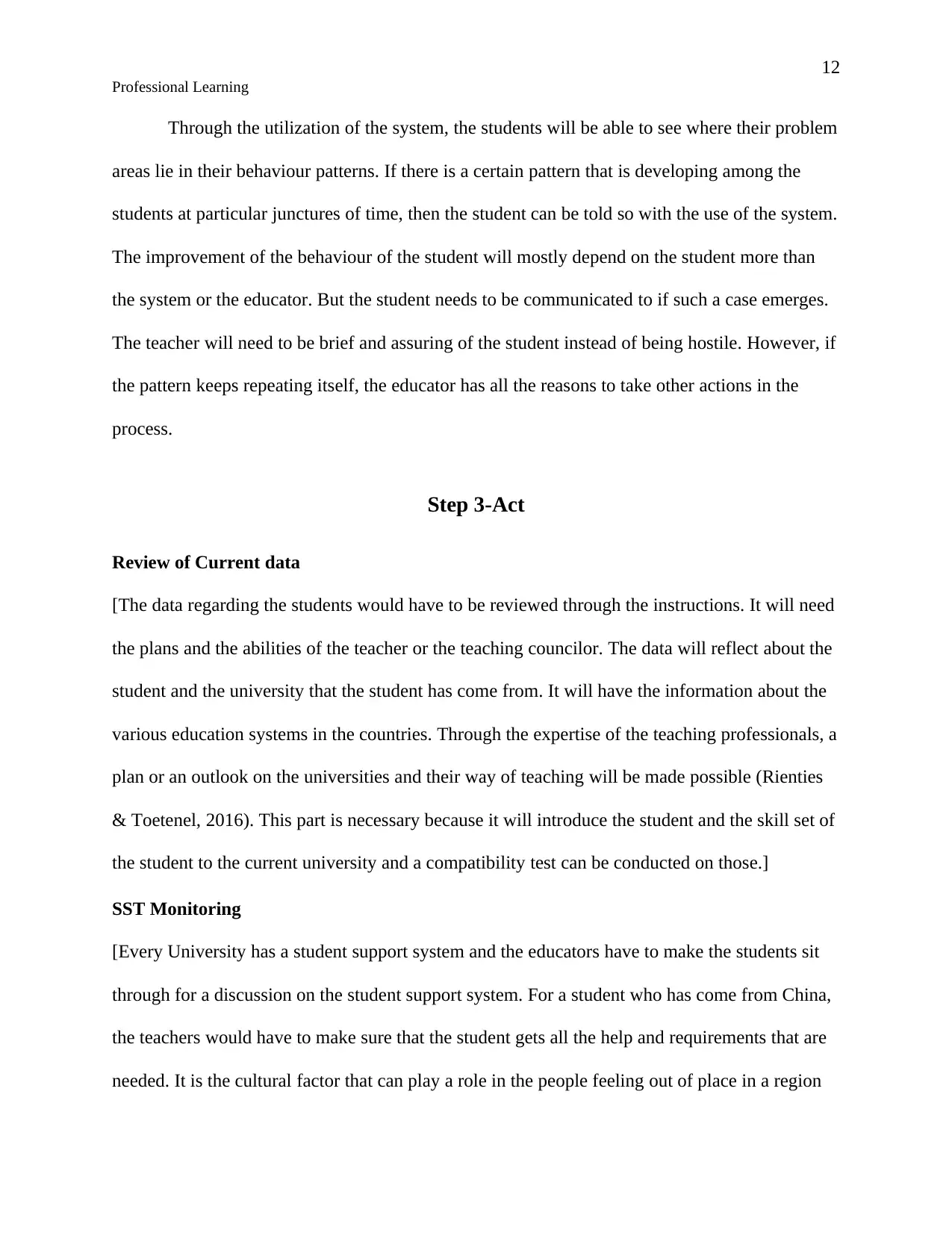
12
Professional Learning
Through the utilization of the system, the students will be able to see where their problem
areas lie in their behaviour patterns. If there is a certain pattern that is developing among the
students at particular junctures of time, then the student can be told so with the use of the system.
The improvement of the behaviour of the student will mostly depend on the student more than
the system or the educator. But the student needs to be communicated to if such a case emerges.
The teacher will need to be brief and assuring of the student instead of being hostile. However, if
the pattern keeps repeating itself, the educator has all the reasons to take other actions in the
process.
Step 3-Act
Review of Current data
[The data regarding the students would have to be reviewed through the instructions. It will need
the plans and the abilities of the teacher or the teaching councilor. The data will reflect about the
student and the university that the student has come from. It will have the information about the
various education systems in the countries. Through the expertise of the teaching professionals, a
plan or an outlook on the universities and their way of teaching will be made possible (Rienties
& Toetenel, 2016). This part is necessary because it will introduce the student and the skill set of
the student to the current university and a compatibility test can be conducted on those.]
SST Monitoring
[Every University has a student support system and the educators have to make the students sit
through for a discussion on the student support system. For a student who has come from China,
the teachers would have to make sure that the student gets all the help and requirements that are
needed. It is the cultural factor that can play a role in the people feeling out of place in a region
Professional Learning
Through the utilization of the system, the students will be able to see where their problem
areas lie in their behaviour patterns. If there is a certain pattern that is developing among the
students at particular junctures of time, then the student can be told so with the use of the system.
The improvement of the behaviour of the student will mostly depend on the student more than
the system or the educator. But the student needs to be communicated to if such a case emerges.
The teacher will need to be brief and assuring of the student instead of being hostile. However, if
the pattern keeps repeating itself, the educator has all the reasons to take other actions in the
process.
Step 3-Act
Review of Current data
[The data regarding the students would have to be reviewed through the instructions. It will need
the plans and the abilities of the teacher or the teaching councilor. The data will reflect about the
student and the university that the student has come from. It will have the information about the
various education systems in the countries. Through the expertise of the teaching professionals, a
plan or an outlook on the universities and their way of teaching will be made possible (Rienties
& Toetenel, 2016). This part is necessary because it will introduce the student and the skill set of
the student to the current university and a compatibility test can be conducted on those.]
SST Monitoring
[Every University has a student support system and the educators have to make the students sit
through for a discussion on the student support system. For a student who has come from China,
the teachers would have to make sure that the student gets all the help and requirements that are
needed. It is the cultural factor that can play a role in the people feeling out of place in a region
⊘ This is a preview!⊘
Do you want full access?
Subscribe today to unlock all pages.

Trusted by 1+ million students worldwide
1 out of 21
Related Documents
Your All-in-One AI-Powered Toolkit for Academic Success.
+13062052269
info@desklib.com
Available 24*7 on WhatsApp / Email
![[object Object]](/_next/static/media/star-bottom.7253800d.svg)
Unlock your academic potential
Copyright © 2020–2025 A2Z Services. All Rights Reserved. Developed and managed by ZUCOL.




